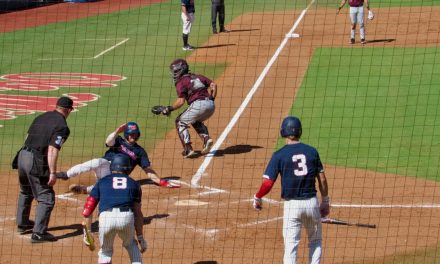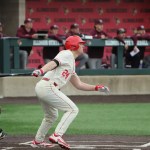
Part One: The 2022-2023 Ole Miss Basketball Chronicles

OXFORD, Miss — Let me introduce you to a new basketball season, and with that new season comes a new series showcasing all there is to know regarding Ole Miss Men’s Basketball. This series will help answer your questions about the Rebels’ program.
Today in part one, we will highlight Kermit Davis and take a deeper dive into the construction of this season’s roster, how he’s planning to solve some of the issues from last year’s team, and look at the projections for this team and program.
The 2022-2023 regular season begins on November 7; however, there has already been some action.
Earlier, Ole Miss travelled to a neutral site to play — as Jeff Goodman would put it — a “not-so-secret scrimmage” against Clemson. These games are tough to evaluate as every coach handles them differently. Some focus on situationals, while some play a majority of the players, and others choose to play their full roster.
Then Ole Miss took on West Georgia in front of a crowd at the S&J Black Pavilion. Backed behind a 16 point outing from Jaemyn Brakefield, Ole Miss won the game 91-62. This was their final tune-up ahead of the regular season tip-off against Alcorn State.
A look back to look forward
Kermit Davis enters his fifth year as the head coach at Ole Miss. Last year’s team finished with a 13-19 overall record while going 4-14 in SEC play.
Key Injuries throughout the year to Jarkel Joiner, Robert Allen, and Daeshun Ruffin helped caused the Rebels to struggle to find any sort of rhythm. At the end of the year Ole Miss lost seven players to either graduation/transfer portal, giving Kermit Davis an opportunity to rebuild/restructure the roster.
However, in order to look forward to this season and how this roster was constructed let’s take a look back at last year’s team. Now going through this it may sound like I’m saying Ole Miss is the world’s most flawless basketball team, but the main point is to show how Ole Miss is looking to improve on prior weaknesses in an effort to be a team searching for more wins this year.
Last year Ole Miss may have gotten a reputation as a team that couldn’t score. However, in conference the team had a surprisingly good shooting percentage from the field (44 FG% – 5th SEC) and the perimeter (34.3 3P% – 4th SEC).
The benchmark of a shooter has been debated before, but for this purpose we want to highlight that three of the top five perimeter shooters from last year’s team return. Matthew Murrell led the team with a 38.6% rate from deep, while Jaemyn Brakefield came in second with a close 37.3%. The final returning player was Tye Fagan who shot 33.3%.
Limiting Turnovers by Turning to Ruffin and Co.
The first statistic to highlight was in the turnover category. Ole Miss averaged 12.2 per game and 13.2 in conference. There’s a lot of factors that go into this but for a large portion of the year last year Ole Miss struggled to have a second ball handler to help lead the offense. A good portion of that could be attributed to injuries as for a large part of the year Ole Miss was without one of Jarkel Joiner and Daeshun Ruffin.
Throughout his freshman season, Ruffin showed his ability to work through the learning curve of the collegiate level while also rehabbing from a wrist injury suffered early in the season. The sophomore is going to have an even larger role going into his sophomore year and will be one of the most important players on this Ole Miss roster.
Even after coming off a torn ACL, the expectations for the former McDonald’s All-American are pretty high. In fact, Ruffin was only recently cleared for activities on October 10th. Unfortunately Ruffin suffered a bruise bone leading up to the season. He will be week-to-week for the future but will have a big impact once he returns.
Looking through some of the game logs, we come across the noticeable difference in how Ole Miss’ offense performed under Ruffin and the growth he showed.
In the first seven games of Ruffin’s career, Ole Miss averaged 15.4 turnovers per game. Granted, four of those came with Jarkel Joiner also in the lineup. To show the progression, over the next seven games that number dropped to 11.0 turnovers per game.
Some may say this could go to the team developing a better chemistry as the year went on. One could certainly make that argument, but to me it shows Ruffin became more comfortable running the offense at the next level and took steps to protect the ball — as well as lead.
Going one step farther, I went ahead and compiled a list of all the schools who averaged 11.0 turnovers or fewer for the year and that number totals 46 schools. I then condensed that into the teams from the power six conferences. We got the number down to 14 schools. Of those 14, 9 made the postseason and 8 made the NCAA tournament. This isn’t to say that Ole Miss needs to average 11 turnovers or less but that if Ruffin and company can keep the mistakes lower they’ll be in a chance to win some more games.
The good news is that Ole Miss doesn’t just have to rely on Daeshun Ruffin to be this ball handler either. Kermit has done a good job of both developing and recruiting some more talent despite losing both Joiner and Austin Crowley.
Matthew Murrell, played some point in high school and is a leader at this point who may play spot minutes their. Sophomore James White is primed to take a major leap in scoring responsibility this season and will certainly ease some of the pressure. White exploded in the Bahamas and showcased a strong scoring arsenal on all three levels.
Davis then went out and recruited Amaree Abram who’s been getting plenty of work at point guard with Ruffin rehabbing from injury. Abram will likely see time at the one and the two given the roster construct but he was the leader of a strong SoCal academy team. Abram had the ability to play the point position during the offseason as Ruffin rehabbed and got some run in during the Bahamas. In the scrimmage against West Georgia, Abram posted six assists to only one turnover.
The other is TJ Caldwell. Out of Texas, Caldwell fits the mold of a combo guard. We saw him play some as a lead guard in the Bahamas but he may not see that role as a point very often to start out.
Hitting the Portal to Hit the Glass
Earlier I said that Ole Miss was actually a good shooting team, especially in conference play. However, the Rebels struggled to get a lot of shots in per game. They ranked 216th in the nation in field goal attempts, and they were 10th in the conference during SEC play. There can be a lot of factors that go into this: the pace of your team, the makeup of your team, the oppositions’ pace, rebounding, and much more. It isn’t talked about nearly enough, but Kermit has vastly changed the rebounding outlook for this team.
Last season, Ole Miss averaged 8.7 offensive rebounds per game. That was good for 228th in the nation. While some of this can be attributed to pace, some of it goes to roster construction.
As a good friend of mine says: “Two things can be true at once.” In prior years we heard Davis talk about wanting to get out and play with more pace, resulting in more possessions and ultimately more shots taken. Adversity and game plans may have changed some of this over the course of the year. We saw the team really get out and run in the Bahamas, especially with skilled big men like Jaemyn Brakefield and freshman Malique Ewin showing their ability to start a break.
Last years’s team had two players who recorded greater than 30 offensive rebounds. Those two were Nysier Brooks (87) and Luis Rodriquez (53). Two years ago, there were four players with greater than 40 offensive rebounds. Taking a look at each of these players, we can see the emphasis on how Ole Miss will look to add multiple second chances.
As for the offensive rebounding numbers, Kermit Davis went to the portal to fix that.
When we talk about Jayveous McKinnis, Theo Akwuba, and Josh Mballa, the conversation normally revolves around their defensive accolades; however, these guys also bring much to the offense as well. All three of these players are going to add a gritty physical element that Ole Miss fans may have not seen in a while.
Starting off, let’s look at the total offensive rebounds for each of these three guys.
Theo Akwuba over his last two seasons recorded 98 and 73 offensive rebounds. Last season that number may have dipped as he had a lingering injury that lowered the amount of minutes he played. McKinnis at Jackson State recorded 98, 60 (in 16 games), and 90 over the last three years. Lastly, Mballa recorded 127, 94, and 103 over the last seasons at Buffalo.
Looking a little bit farther, we can examine the offensive rebound percentages for these players. Last season, Nysier Brooks notched a 10.9 offensive rebound percentage. Over the last two years, Theo Akwuba had a 15% (2020-2021) and a 12.8 offensive rebound percentage. That 2020-2021 year saw Akwuba at 14th nationally for this metric.
Jayveous McKinnis had a 11.4%, 13.0%, and a 11.9% over the last three seasons. All four seasons McKinnis was at Jackson State he was either 1st or 2nd in the SWAC in ORP%.
Mballa recorded the three highest of the bunch with a 15.0%, 14.7%, and a 14.0%. Those first two numbers placed him in the top-20 nationally.
If you read all this and may not understand it all, it means one thing. This group is physical and they are really going to be creating all kinds of opportunities for this offense. It’s unrealistic to think they can all keep this percentage but Kermit Davis will look to utilize these strengths so look to have multiple guys crashing the glass.
Answering a couple of mailbag questions
What’s the situation looking like with post players?
One of the better problems to have is a logjam, and this Ole Miss front court certainly has one. Looking at this group, you have McKinnis, Akwuba, Mballa, Brakefield, Robert Allen, and Malique Ewin all vying for minutes at the four and the five.
That’s a lot of love to spread with only so many minutes. However, as I alluded to in the prior section, I think we see a cleaner rotation going into this year. If I were Kermit, I would look to use Awkwuba, Ewin, and Brakefield at center while using McKinnis as a small ball center/screener at times.
Mballa, Brakefield, and Robert Allen are all looking for minutes at the four. While Mballa and Allen are recovering from injuries, this could lead to some more unique lineups to start the season. I think the best thing Ole Miss can do is use this logjam as a positive.
The Rebels really have the potential to rotate these players and use that rebounding tenacity to wear down opponents. If Ole Miss can work the transition and then also have their frontcourt use their physicality to put a toll on opposing teams, it can really open things up for some scoring opportunities down the stretch in the second half of these games.
What role do you think the freshman will play this season?
Ole Miss brought in four players from the high school ranks to add to this roster. Those four are Amaree Abram, TJ Caldwell, Malique Ewin, and Robert Cowherd. While Ole Miss certainly added a lot of experience from the transfer portal — and especially in the backcourt — there is opportunity for early contributions.
Amaree Abram: Daeshun Ruffin is still recovering from his ACL injury last season. However, Kermit announced at Friday’s press conference that Ruffin suffered a bone bruise and will be day to day. When he returns, he will be working his way back into shape. His absence allows Abram to get reps with the first unit at point.
Abram’s defense can keep him on the court this year, but he should play a big role as a primary reserve guard or an off-ball option in smaller pesky defensive lineups. When Abram is in, look for Ole Miss to really push the pace and allow him to attack in transition, or in the halfcourt off of screens. Seeing how well he shoots may be a large factor in how he may be used.
TJ Caldwell: I was pleasantly surprised with what I saw when the team played in the Bahamas. Many people enjoyed the highlight-level dunks from Caldwell, but there were a lot of finer things in his game that can help him see the court early.
He did get the opportunity to play some at the point, but unless there are injuries, I think we may see TJ at the two spot or even the three a little bit. He showed a really good ability to attack the basket and slice through the defense. I think TJ is a guy who can give you a real spark off the bench if he can continue to progress and improve throughout the year.
Robert Cowherd:Abram’s high school-teammate-turned-college teammate didn’t play in the Bahamas after suffering a torn meniscus in the offseason. Cowherd is a wildcard in that sense, but I think we may see him as a reserve guard who can also be a stretch threat whenever shooters are needed.
Malique Ewin: Dealing with that logjam up front will make minutes tougher to come by in year one. I do think he showed enough to be out on the floor for stretches of the game. Ewin’s ability to be a guard out on the perimeter could get him some more action. He will contribute off the bench as a reserve center or tall-ball four in a jumbo-sized lineup.
A lot of these questions will be answered as we get into the season. There is certainly bound to be progression from this squad but there are plenty of things to be excited about from the youngsters.
TJ Oxley is the Vice President of Operations and the Director of Community Relations for The Rebel Walk. He is also the Director of Basketball Content and Senior Basketball Writer. He has over five years of experience providing in-depth analysis of college basketball through multiple platforms. A former MBA graduate of Ole Miss, TJ started with The Rebel Walk in 2019.























Trackbacks/Pingbacks